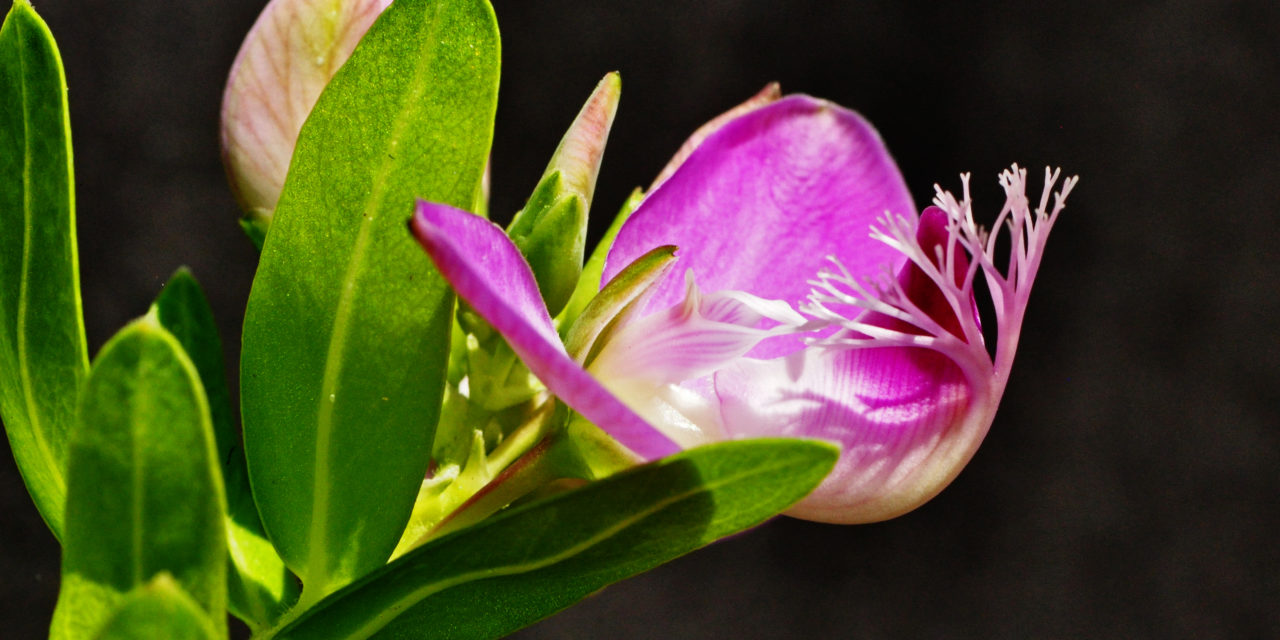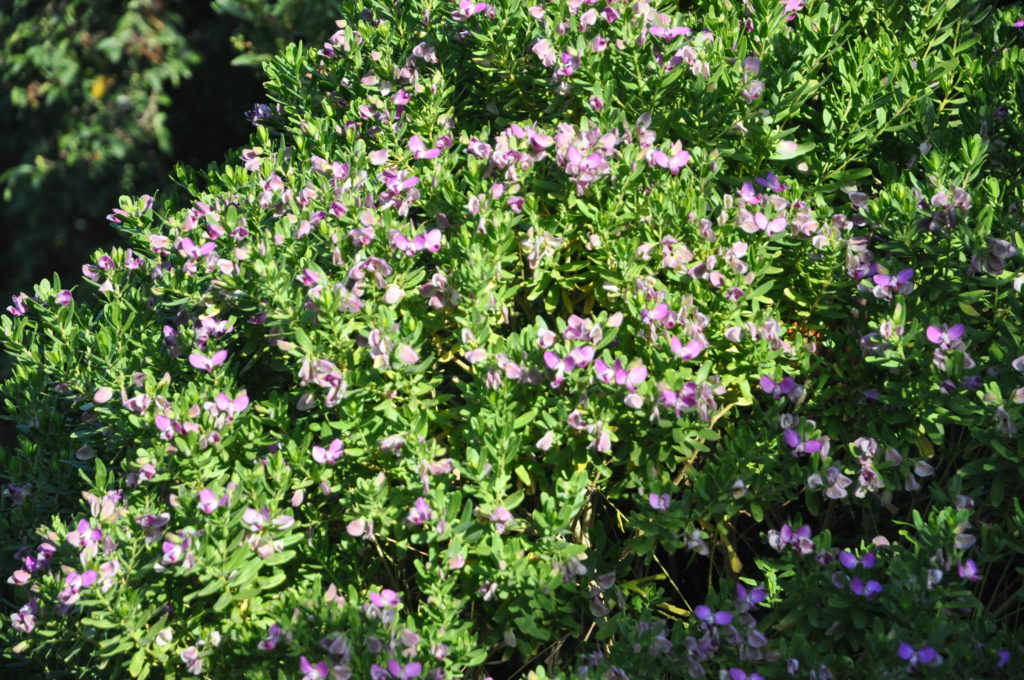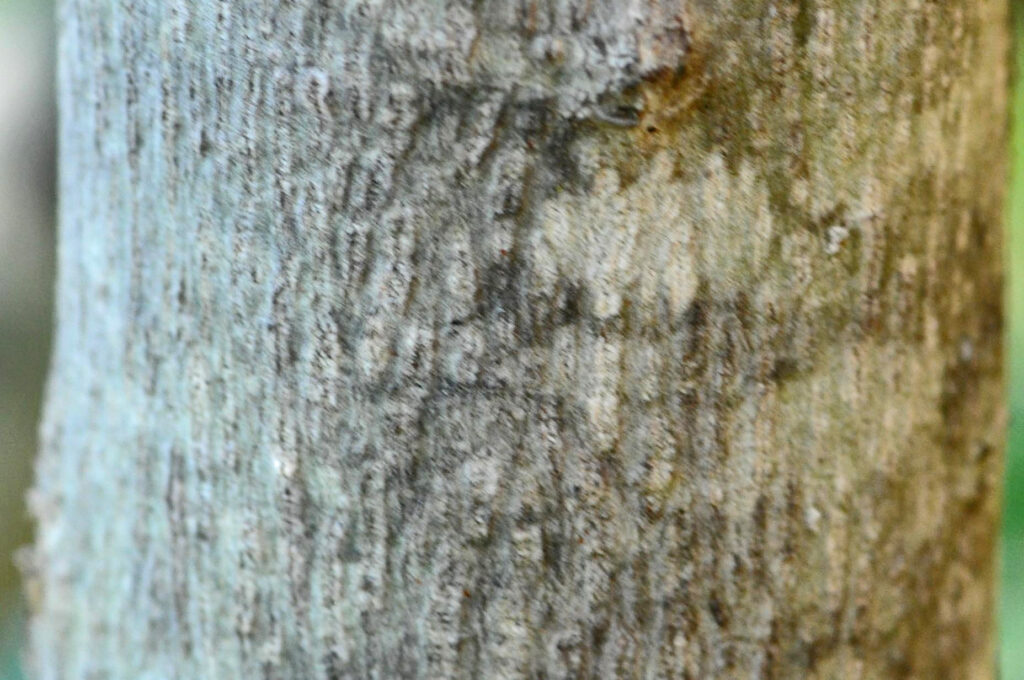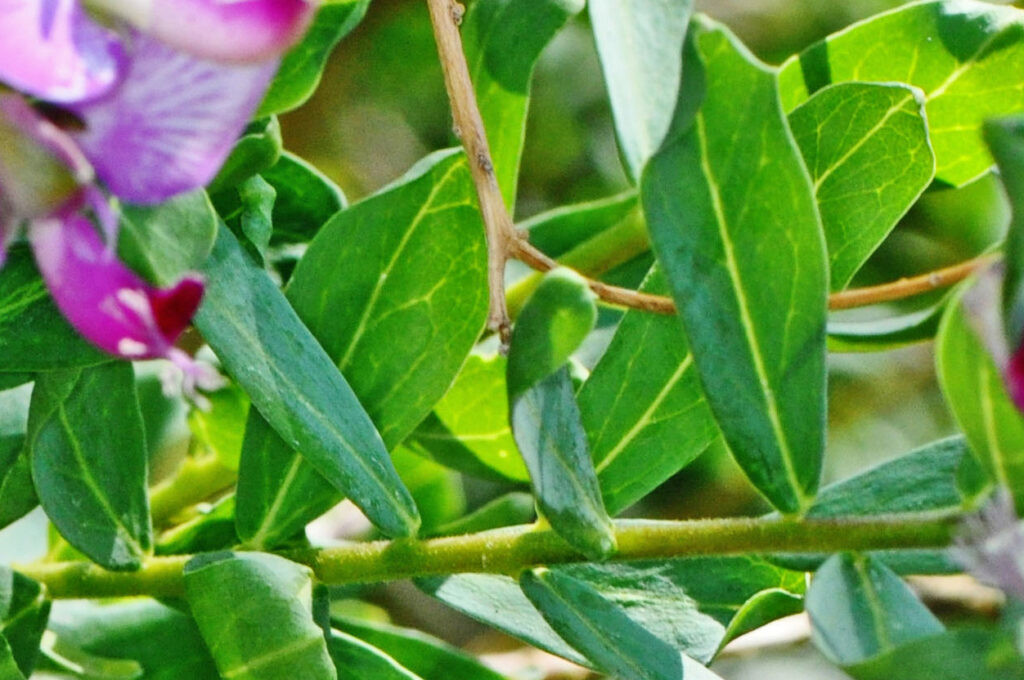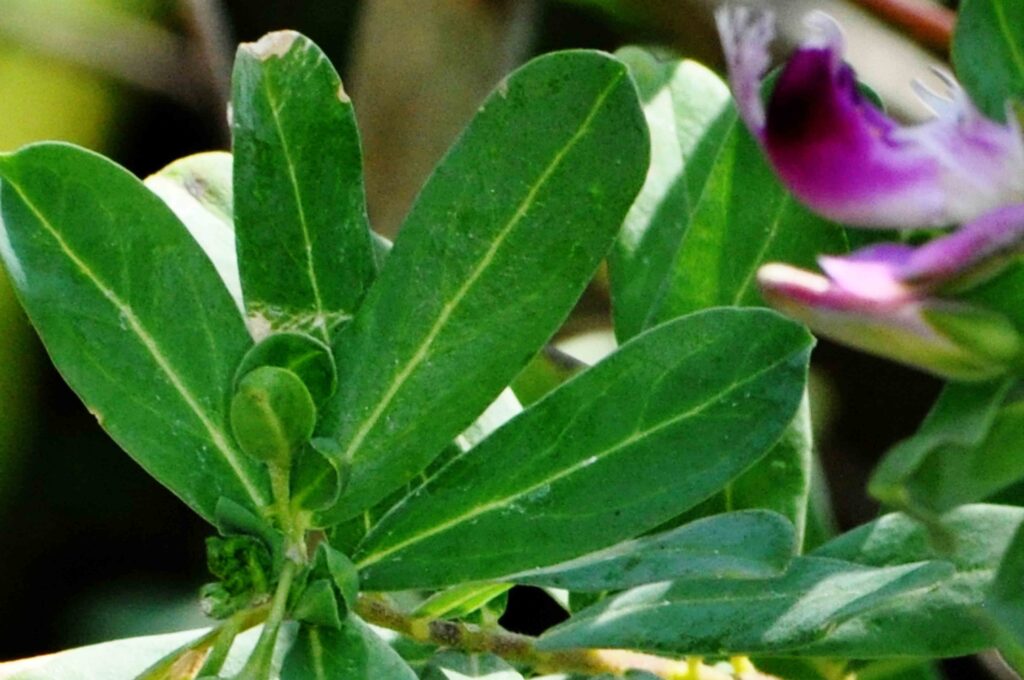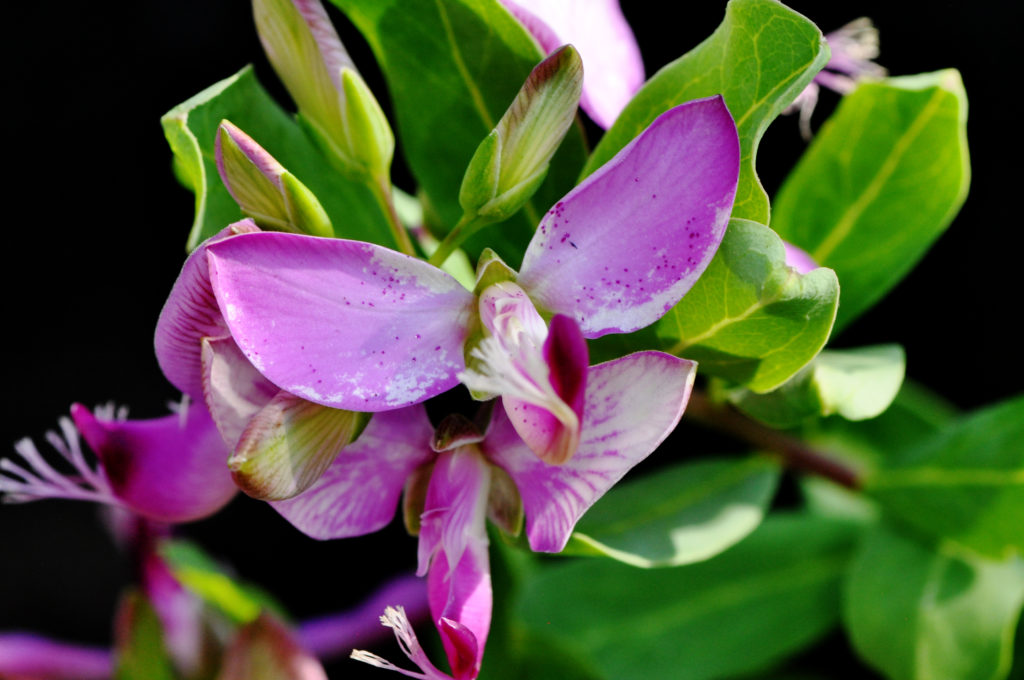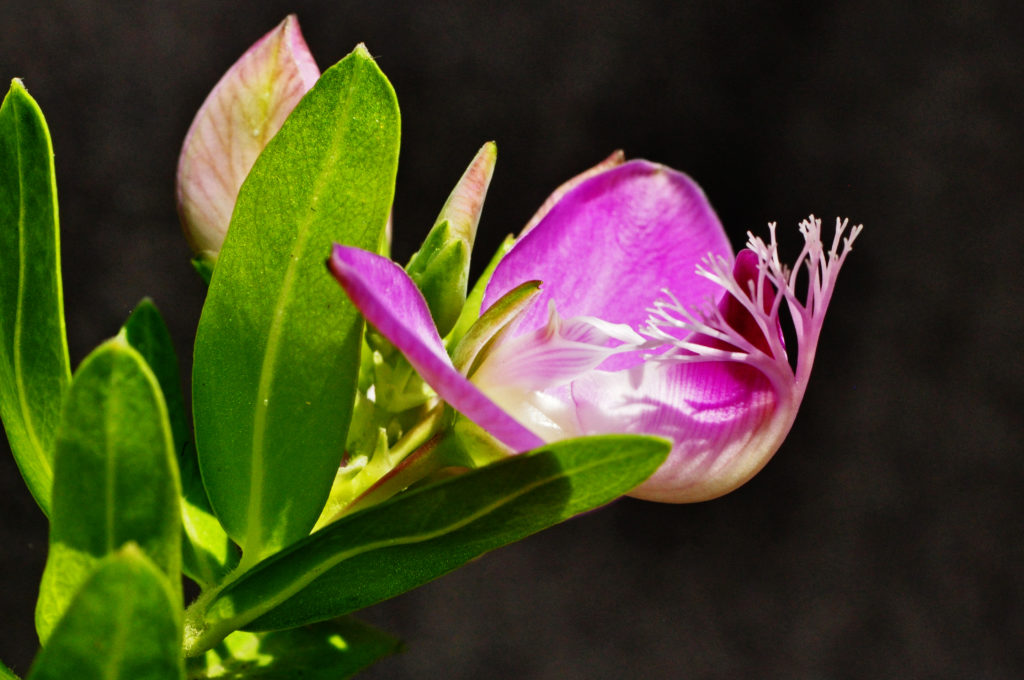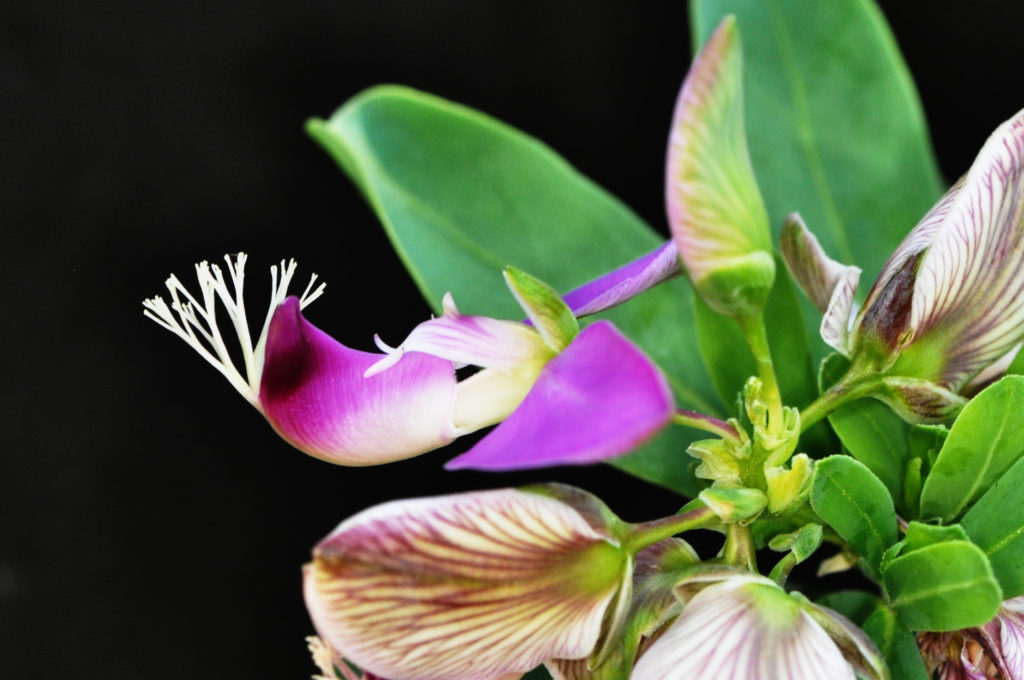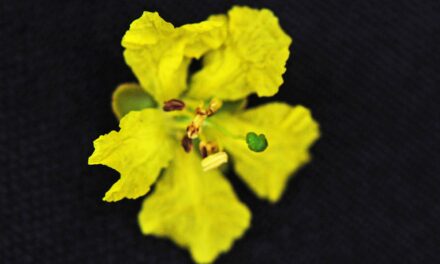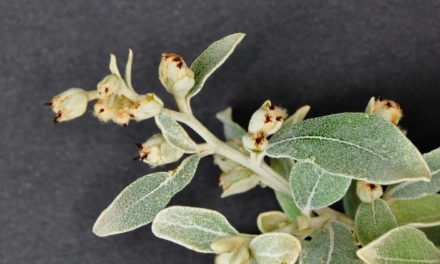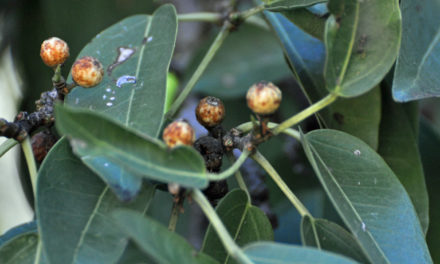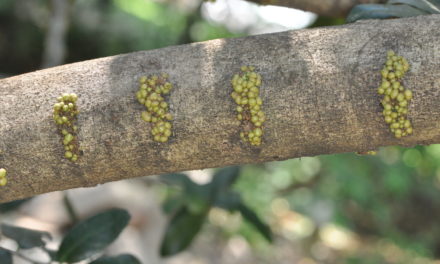General Info – summary
This hardy shrub or small Tree is up to 4m high & has a trunk up to 15cm wide. The alternate Leaves are simple and lack stipules. Bisexual, zygomorphic Flowers occur in terminal racemes and have 2 large petal-like sepals & only 3 petals are present. There is no standard petal & flowers appear all year round -mainly in spring and summer. Fruit is a dehiscent capsule. The 1 or 2 Seeds may have persistent sepals.
Description
Polygala myrtifolia
Previous Names: Polygala pinifolia.
SA Tree No. 302.1.
Common names: (Afr) Augusbossie, Augustusbossie, Blou-ertjieboom, Bloukeurboom, Langelede, Langelier, Septemberbos, Septemberbossie. (Eng) September Bush. (isiXhosa) Ulopesi, Umabala-bala.
Family: Polygalaceae (Milkwort family). These plants may be Herbs, shrubs, or small trees. The Leaves are alternate, sometimes in a condensed or in a close cluster but are rarely opposite. They are simple, entire, and stipules are absent. Inflorescences are variable. Flowers are bisexual, irregular and usually solitary, axillary or terminal. There are 5 free and imbricate Sepals. There are 3 or 5 Petals which are united at base and adnate to a staminal tube. Lateral petals are small. There are usually 8 or 5 Stamens, and the filaments are usually connate into a slit tube. The Ovary is superior and contains 1 pendulous ovule in each locule. The Style is simple, and 2-lobed at the apex. 1 lobe stigmatic, the other often ending in a tuft of hairs. Fruits are various. Seeds often hairy, often with an attached aril. This family has 80 genera and in excess of 950 species. There are 5 genera and 211 species in southern Africa. Local genera with trees on this website include Polygala and Securidaca.
Name derivation: Polygala – much milk – some farmers believe that some members of this family increases milk flow in cattle. myrtifolia – like leaves in myrtle (Myrtus communis – in the family Myrtaceae). The genus Polygala has about 360 species with 88 in the South Africa.
Conservation: National Status: L C. (Least Concern). Assessment 2005 (W Fodder and L Potter).
Tree
This plant is usually a shrub. Occasionally it may become a 4m high Tree with a wide Crown and many upright branches. The Stem (main axis of the plant, the leaf and flower bearing as distinguished from the root-bearing axis) has a diameter of up to 15cm. The slender branches are usually upright and young branches are green and hairy (photo 719). The smooth mature Bark is grey-brown (photo 716).
- 355. 2018/06/23. Umngazi. Photo: David Becking.
- 716. 2014/09/13. Lowveld NBG. Photo: David Becking.
Leaves
The spiralled (photo 719), soft, bright or dark green Leaves are clustered along slender branchlets. All leaves are simple (have a single blade which may have incisions that are not deep enough to divide the leaf into leaflets). Each oblong, obovate or oval leaf is up to 5 x 1,3cm. Leaves are more than twice as long as wide and, in dry areas, the leaves may be nearly needle-like. They are thinly textured and glabrous (hairless). The Midrib is the clearly visible (photo 719M) and extends to the apex. When the leaf is held against a strong light, the other veins are more clearly visible. Otherwise, the lateral and net veining are inconspicuous. The Margin is rolled under and entire (with a continuous margin, not in any way indented). The Apex is rounded and a short tipped bristle may be visible (photo 682 – under Flowers). The Base tapers broadly. The Petiole (leaf stalk) is small or absent (photo 719 – under Flowers). Stipules (basal appendages of the petiole) are absent.
- 719. 2014/09/13. Lowveld NBG. Photo: David Becking
- 719M. 2014/09/13. Lowveld NBG. Photo: David Becking.
Flowers
The impressive Flowers only superficially resemble those of the sweet pea in the Fabaceae (Legume) family. Here the flowers are bisexual and zygomorphic (floral parts are unequal in size or form so that the flower is capable of division into essentially symmetrical halves by only one longitudinal plane passing through the axis). Each flowers is about 2,5cm long. Often conspicuously veined flowers (photo 720) are located in short terminal or lateral Racemes (simple, unbranched, indeterminate inflorescence with pedicellate – stalked flowers along the axis that open in succession towards the apex). Flower Buds are green and the lower ones open first. The Calyx consists of 5 free, imbricate (having regularly arranged, overlapping edges, as roof tiles or fish scales) and unequal Sepals. The 2 larger lateral blue sepals are wing-like and resemble petals (photo 715). Unlike the sweet-pea flowers, the Corolla has only 3 Petals. Two are small, wing-like and somewhat hidden from view. The third, lowermost single petal is keeled (boat-shaped) with a feathery, fringed showy crest that is attached below the apex (photo 720). Unlike the sweet pea, the upper standard (vexillum) petal is missing. Each flower is mauve to bright purple and often has darker veins. There are varieties with white, pink or crimson flowers.
In the Male flower part, there are 7 fertile Stamens and 1 Staminode. The Female element of the flower has a single Pistil (a unit of the Gynoecium – composed of the Ovary, Style and Stigma) with a superior 2-locular Ovary containing 1 pendulous Ovule in each locule. The simple Style is curved or bent, and the Stigma is oblique. Flowers tend to close at night. They appear year-round but mainly during winter and spring. Carpenter bees are responsible for pollination. (May-Sep – all year).
- 715. 2014/09/13. Lowveld NBG. Photo: David Becking.
- 682. 2014/09/13. Lowveld NBG. Photo: David Becking.
- 720. 2014/09/13. Lowveld NBG. Photo: David Becking.
Fruit
The small, flattened, ovoid, (brown when mature), slightly winged Fruit is a dehiscent, membranous Capsule (a dry oval or brow fruit resulting from the maturing of a compound Ovary, which usually opens at maturity by one or more lines of dehiscence). Persistent Sepals surround the capsule. Occasionally only 1 Seed develops. Present is an indumentum (a dense, fine hairy covering) and an Aril (an appendage or outer covering of a seed that may appear as a pulpy covering. It develops from a stalk, the funiculus, connecting an ovule or a seed with the placenta). (All year).
Distribution & Ecology
This Plant is located mainly in coastal dune bush, on forest margins, streams banks and grassy hillsides – up to an altitude of 1 400m. It is common in disturbed soil as well as sandy soils and sand dunes. In South Africa this plant occurs up to 1 350m and is located in the Northern Cape, Western Cape including Table Mountain. Here it exists in a typical Fynbos (a belt of natural shrubland or heathland in the winter rainfall area) component. It is also found in the Eastern Cape, KwaZulu-Natal – e.g., Giants Castle and in Gauteng. This Pioneer plant (hardy species which are often the first to colonize previously disturbed areas) adjusts to the environment that it is in. It is considered a weed in South Western Australia. It has now become naturalised (living wild in a region where it is not indigenous) in New Zealand and California.
Ethnobotany
This plant is widely cultivated. Seeds germinate easily and those planted in full sun do the best. The plant can withstand coastal conditions and, if pruned regularly, can make an attractive hedge. This is a good garden plant. It is fast growing and may flower after 3 years. Research at the University of KwaZulu-Natal showed that aqueous extracts from Polygala myrtifolia have antifungal properties (in this case against Candida albicans, which is an opportunistic pathogenic yeast that is a common member of the human gut flora).
References
References:
Boon, R. 2010. Pooley’s Trees of eastern South Africa. Flora and Fauna Publications Trust, Durban.
Coates Palgrave, M. 2002. Keith Coates Palgrave Trees of Southern Africa, edn 3. Struik, Cape Town.
Foden, W. & Potter, L. 2005. Polygala myrtifolia L. var. myrtifolia. National Assessment: Red List of South African Plants version 2020.1. Accessed on 2023/10/12.
Lawrence, G. H. M, 1951. Taxonomy of Vascular Plants. The Macmillan Company, New York. Tenth Printing 1965.
Palmer, E. & Pitman, N. 1972. Trees of southern Africa. Balkema, Amsterdam, Cape Town.
Schmidt, S. Lotter, M. & McCleland, W. 2002. Trees and Shrubs of Mpumalanga and the Kruger National Park. Jacana, Johannesburg.
van Wyk, B. & van Wyk, P. 1997 Field guide to Trees of Southern Africa. Struik, Cape Town.
http://plantzafrica.com/plantnop/polygalamyrt.htm
http://researchspace.ukzn.ac.za/xmlui/handle/10413/8549
https://florabase.dpaw.wa.gov.au/browse/profile/8395
http://posa.sanbi.org/flora/browse.php?src=SP
http://static1.kew.org/science/tropamerica/neotropikey/families/Polygalaceae.htm
https://en.wikipedia.org/wiki/Candida_albicans

